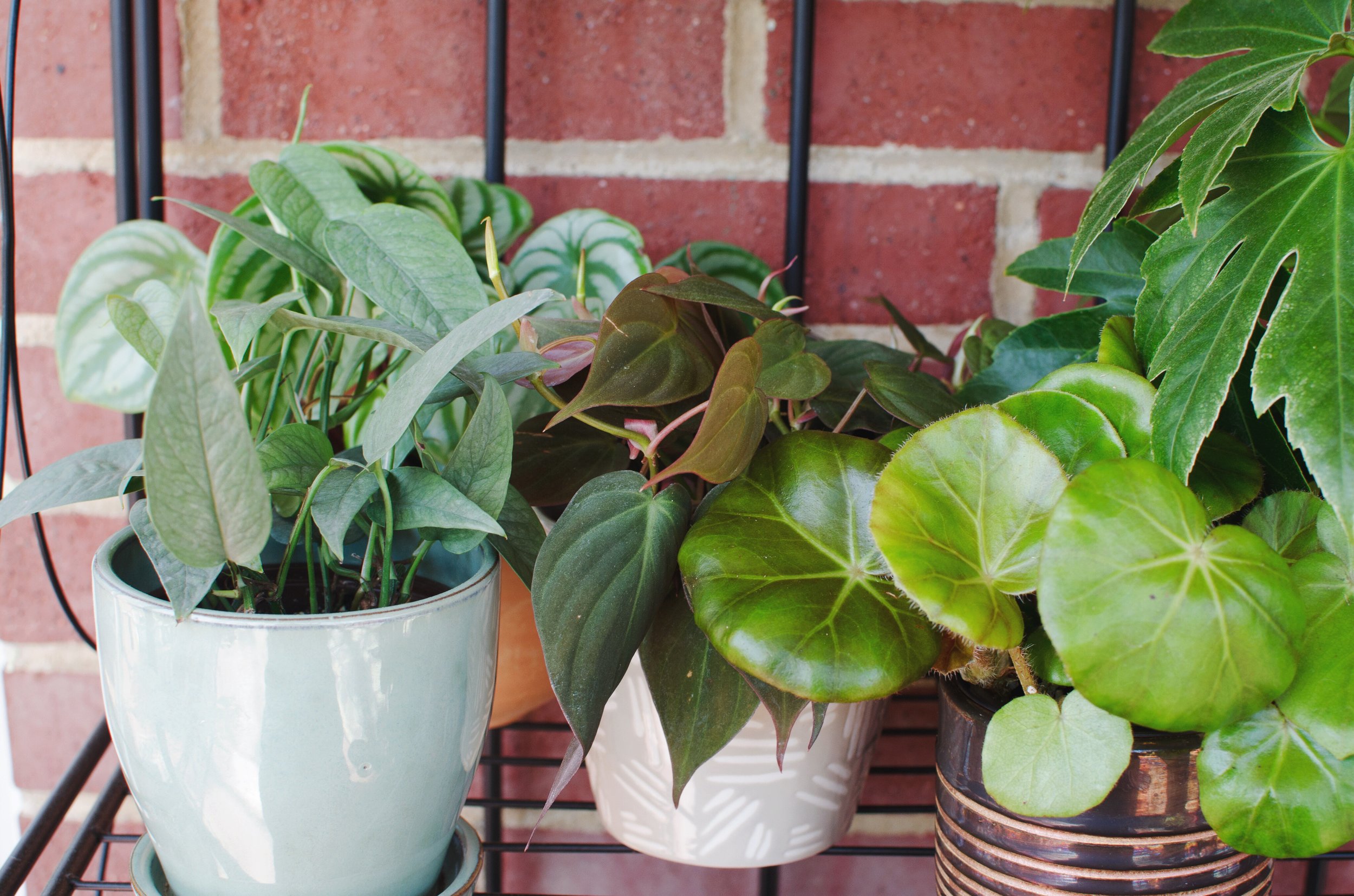Elements of plant care: moving your houseplants outside
You may ask why anyone would move houseplants outside... doesn’t that defeat the purpose of having plants in your home? I don’t think so, since you get to enjoy them indoors all autumn and winter long & create a jungly oasis outside! Plus, there are plenty of benefits to moving your plants to a perfect spot outside during warm spring and summer months (aka growing season). If you have a porch, patio, or balcony that is partially covered or partially shaded, I highly recommend you take advantage of it! Moving your plants outside gives them an environment that more closely mimics their natural habitat and plants will appreciate the additional light, humidity, and warmth found outdoors.
Just some of my collection out enjoying fresh air!
Benefits of moving your plants outside:
- More light - Even a shady spot outside is going to be brighter than a sunny indoor window, because glass window panes filter out much of the sun’s UV rays. It's also easier to give sun-lovers like cacti, crotons, and palms the full light they need outdoors.
- Higher humidity - As warmer months approach, humidity gets higher, especially if you’re closer to the equator! Here in the southern US, the humidity is practically swamp-like in the thick of summer. Since the majority of houseplants hail from tropical rainforests, they will absolutely LOVE the extra humidity. Just take care to provide adequate circulation; this can be done by not crowding your plants too closely together and/or by running a fan. I’m lucky because my porch features an overhead fan that I use when it gets sticky humid!
- Warmer daytime temperature + cool nights - again, think about a plant's natural habitat; whether in the rainforest or in the desert, nights will always be cooler. Temperatures stay relatively the same indoors, so giving plants the naturally fluctuating temperatures outside helps them be more in tune to their natural environment.
These plants are placed in an area that will get bright shade most of the day and a touch of direct light in the morning.
Factors to consider when moving plants outside:
- Outdoor temperatures - Temps will be the number one factor in determining when you should place your plants outside and when you should bring them back inside. Most houseplants are happy with temperatures above 60-65 degrees Fahrenheit, but research your plant just to make sure. For example, many desert-dwelling plants are quite cold hardy, while other tropical plants demand temperatures over 70 degrees. Typically in the first month of spring where temps fluctuate so much, I place plants out for the day and bring them in at night. I will leave plants out semi-permanently once nighttime temps stop dipping below 65 degrees and bring them in around mid-late autumn. Again, I stress that it's dependent on the plant, so please double check what temperatures your plant can handle! And always check the weather - I have an app on my iPhone that I check every morning.
- Placement for optimal light - Take inventory of your plants and their lighting needs. Shade-loving plants, full sun plants, plants that like like a little direct light... make sure your space outdoors can accommodate the plant! You don't want to put your collection of calatheas in blazing direct sun all day, or your opuntia cactus in a darker spot of your porch. My porch faces east and gets a bit of morning direct sun, which is fine for most tropical plants. It will be different if you have a blazing bright south-facing area, or a completely shaded north area.
- Acclimating your plants - It can be a bit of a shock to your plant to go from indoors to out, so it's best to acclimate them slowly to the higher light levels. For example, if you have a Sansevieria (snake plant) in a low light spot in your house that you want to move to your porch, first move it closer to a window indoors for about a week. In a few days, move it to a shady spot outside, and then in another few days, you can place it in full sun (yes, snake plants CAN be in full sun and they love it... if properly acclimated!). If you don't acclimate your plants, you risk burning the foliage.
- Pest control - plants are no more prone to pests outdoors than they are indoors, but it's still best to take precautions. I personally like to spray everything down with neem oil once I place them outside. There are many pest prevention techniques that you can choose depending on your own personal preferences... and it's definitely a blog post for another time! :) I believe it's better to take precaution against pests instead of trying to fight a long, hard battle once your plants are infested.
- Watering more often - since your plants are getting more light and temperatures are higher outdoors, watering will increase. The best practice is to stick your fingers in the top of the soil to check dryness. For me personally, if I have to water an indoor plant around once a week, it usually increases to every 3-4 days outdoors. Again, it's totally dependent on the plant, the container it's in, light, and temps! Use your best judgement, but be aware you'll be watering more often.
A few aroids, who love increased humidity outdoors.
Moving your plants back inside:
- Cleaning and pest prevention - I personally like to give all of my plants a thorough shower when I bring them back inside for off-season. Tepid water will rinse off any debris, dust, and pollen, or any renegade bugs hitching a ride in your plant. I’ll usually paw through bigger plants and leafy plants to check for any insects, too. I then apply more neem oil after this for good measure!
- Acclimation - Just like you acclimated your plants to brighter light, you may have to acclimate them to lower light! Use the same process, just in reverse.
I hope this post covers any questions or concerns you have about moving your houseplants around! As always, let me know in the comments or feel free to shoot me an email/message on social media. Thanks for reading!



